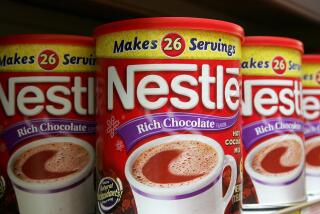The Cooks : Tea Time for Chocolate Lovers : Chocolate: From the halls of Montezuma to a chocolate sandwich.
- Share via
Columbus brought cacao beans back to Spain after his fourth voyage to the New World in 1502, but it was Cortez and his band of conquistadores who first understood their use, after seeing Montezuma II drink the frothy liquid made from the beans out of golden goblets.
The first chocolate drinks popular in Europe were made the same way as in the Americas--by roasting, then grinding the kernels of the cacao beans into a coarse paste called chocolate liquor. This mixture--roughly half cocoa powder and half cocoa butter--was combined with sugar and spices such as cloves, cinnamon and vanilla, to form cakes that could be dissolved in hot water. The chocolate, however, had to be vigorously whisked in an attempt to emulsify the cocoa butter with the water.
In 1828, an innovation enabled the chocolate confections that we know today. Conrad van Houten, whose family ran a chocolate business in Amsterdam, was looking for a way to make chocolate less oily so that the drink would be lighter. He developed a screw press that would remove most of the oil from the bean.
The result was cocoa powder, and hot chocolate became a different drink--the one that we know today. Van Houten’s press also made modern chocolate candy possible by allowing the re-addition of cocoa butter to the cocoa powder, resulting in a smoother, malleable paste. The first “eating” chocolate was introduced in England in 1847--and mankind has never been quite the same.
Chocolate lovers should know that chocolate contains, although in insignificant amounts, two drugs: theobromine, a diuretic, and caffeine, a stimulant. It also contains phenylethylamine, a chemical that affects the involuntary nervous system. (However, to get enough phenylethylamine for a drug euphoria would require eating more chocolate than even the most hopeless chocoholic is capable of.)
One of the more surprising fats found in nature, cocoa butter will keep for years before turning rancid. It turns quickly from solid to liquid and, since it has a melting temperature slightly below our body temperature, excellent chocolate always feels cool when it melts in the mouth. Less expensive chocolates, to which other fats are added, do not give the same sensation.
Eventually, good chocolate develops a white coating when the fat particles migrate to the surface. Ignore it--this is not a problem; the fat will reintegrate when you use the chocolate.
All chocolate scorches easily, so melt it slowly over hot water. If chocolate becomes hard and grainy during melting, add a little vegetable shortening to it to bring it back.
You can substitute cocoa powder for chocolate. Add 3 tablespoons cocoa powder to 1 tablespoon softened butter for each ounce of chocolate. Do not simply add cocoa powder to a cake when chocolate is called for--the powder has a certain flour-like quality that must be compensated for.
In cakes and cookies, a little vinegar will deepen the color of chocolate and especially of cocoa powder.
Using cocoa powder instead of chocolate in cooking means that we can use chocolate for its true bitter, sultry flavor rather than for its familiar sweet seductiveness. I find chocolate terrific in savory as well as sweet concoctions.
CHOCOLATE TEA SANDWICHES WITH CHICKEN MOLE
2 tablespoons olive oil
1 teaspoon minced garlic
1/4 cup finely minced onion
1 pound boneless chicken breast
2 teaspoons unsweetened cocoa powder
1 teaspoon chili powder
1/4 teaspoon ground cumin
Dash ground cinnamon
Salt, pepper
1/2 cup water
Muffins
Heat oil in covered skillet large enough to hold chicken over medium heat. Saute garlic and onion 1 minute. Add chicken, cocoa powder, chili powder, cumin, cinnamon, salt and pepper to taste and water. Cover and simmer until chicken is done, about 8-12 minutes.
Transfer chicken to plate. When cool enough to handle, dice into 1/4-inch pieces. Cook remaining mixture until thickened. Spoon over chicken. Let cool.
Split muffins in half. Place small amount Chicken Mole on top of bottom half and replace top. Repeat with remaining muffins. Arrange on platter and serve. Makes 4 to 6 servings.
Muffins
1/2 cup plus 2 tablespoons bread flour
2 1/2 tablespoons unsweetened cocoa powder
1/4 teaspoon baking soda
1/4 teaspoon salt
1 tablespoon sugar
1/2 cup water
3 tablespoons oil
1 1/2 teaspoons white vinegar
Stir together bread flour, cocoa powder, baking soda, salt and sugar in mixing bowl. Pour in water, oil and vinegar, stirring until smooth.
Spoon batter into 12 greased small (2-ounce) muffin tins. Bake at 325 degrees about 15 minutes or until wood pick inserted in center of muffin comes out clean. Cool. Makes 12 small muffins.
CHOCOLATE TEA CAKES
5 tablespoons butter, softened
3/4 cup granulated sugar
1/2 pound semisweet chocolate, melted
4 eggs
1/2 cup flour
Powdered sugar
Cream butter and granulated sugar until light in mixer bowl. Slowly add melted chocolate. Add eggs, 1 at time, beating well after each addition. Add flour and mix only until incorporated.
Brush 8-inch-square cake pan with butter and sprinkle with flour, shaking off excess. Pour in batter. Bake at 350 degrees about 20 minutes until puffed, or until wood pick inserted in center comes out clean.
Cool before removing from pan. Sprinkle with powdered sugar and cut in 2x3/4-inch pieces. Makes about 36 small cakes.
More to Read
Eat your way across L.A.
Get our weekly Tasting Notes newsletter for reviews, news and more.
You may occasionally receive promotional content from the Los Angeles Times.










